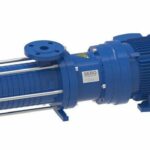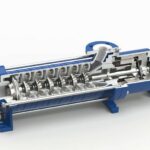Technologies for the capture and storage of CO2 make an important contribution to the decarbonisation of industrial processes. CCS plants are therefore currently being built primarily where the greenhouse gas is produced in large quantities in industrial processes – in power plants operated with fossil, substitute or residual fuels, in the chemical industry, in oil and gas refineries, in the cement industry, in iron and steel mills, and in the maritime industry. Another effect of capturing and storing CO2 is the generation of environmentally neutral energy, for example in the production of blue hydrogen or the provision of liquefied CO2 for heating purposes, for process engineering or in the shipping industry. After the capture process, the CO2 is fed into a compression stage where it is compressed under high pressure to around 100 bar so that it can be transported as a liquid phase to the point of use or storage. Pumps play an important role in the entire CCS process. In particular, side channel pumps from Sero Pumpsystems meet the necessary technical requirements to be used in many places along CCS infrastructure chains from capture to transport to permanent sequestration under the seabed, in rock strata or in empty oil and gas fields.
Principle of the side channel pump
Side channel pumps have a number of features that benefit them when used in CCS plants. Thanks to their self-priming operating principle and their holding pressure head – the lowest NPSH value is just 0.2 m – side channel pumps such as the SHP series or the SEMA-S…TT offer optimum integration possibilities. Extremely low inlet heads can be realised when taking off from a tank – which avoids special structural or design measures on the system. The wide speed range of the pumps makes it possible to adjust the delivery volume variably and thus to pump liquid carbon dioxide or ammonia as CO2 carrier without pulsation. Another characteristic of side channel pumps is their large delivery head and very steep characteristic curve – depending on the series and design, it extends up to 1100 m.
Designed for high pressures
Side channel pumps operate under demanding process conditions in CCS plants. For example, they are designed and specified for high pressures of up to 100 bar – far more than the 15 bar that must be mastered in the transport and storage of compressed, liquefied CO2. At the same time, they are suitable for a wide range of media temperatures from -60 °C to 220 °C. Low-temperature fluids such as CO2 and ammonia, which change from a gaseous to a liquid state at temperatures of around -57 °C and -33 °C respectively, can thus be reliably transported – because the side channel pumps are specially designed for this in several respects. Spring assemblies configured for this purpose compensate for thermal expansion as well as contraction of the hydraulics, as occurs when the pump is filled by the pumped medium or at standstill. Additional elongation inserts prevent temperature-related stresses in the pump body. The plain bearing was designed with a dimensionally optimised fit. Finally, special thrust washers minimize possible wear effects and thus ensure increased operational reliability.
Reliable two-phase conveying
Another advantage offered by side-channel pumps is their ability to maintain uninterrupted pumping performance even when gas components occur in the liquid CO2. If the pressurisation changes and media temperatures reach their boiling points, liquid carbon dioxide and ammonia tend to successively change to the gaseous state. In such a case, side channel pumps operate very reliably for a long time, because they keep the flow rate largely constant even in the event of pressure fluctuations and can even pump two-phase flows with up to 50 % gas content without cracking. Problems due to possible vapor bubble formation and thus effects on the delivery or metering rate are thus reliably excluded.
Implemented CCS plant projects
The advantages offered by side-channel pumps in the capture and storage of CO2 are already being used in various CCS projects and pilot plants. Among them is Wärtsilä Marine Systems, which has taken a central role in CCS technology. For example, Wärtsilä is developing the industry‘s first on-board carbon capture and storage technology. As such, CCS presents an immediate opportunity for sustainable shipping. Through its collaboration with Axflow AS, Sero Pumpsystems has supplied pumps for Wärtsilä test facilities.
Sero Pumpsystems GmbH, Meckesheim
Author: Klaus Reischl
Sales Manager,
Sero Pumpsystems









